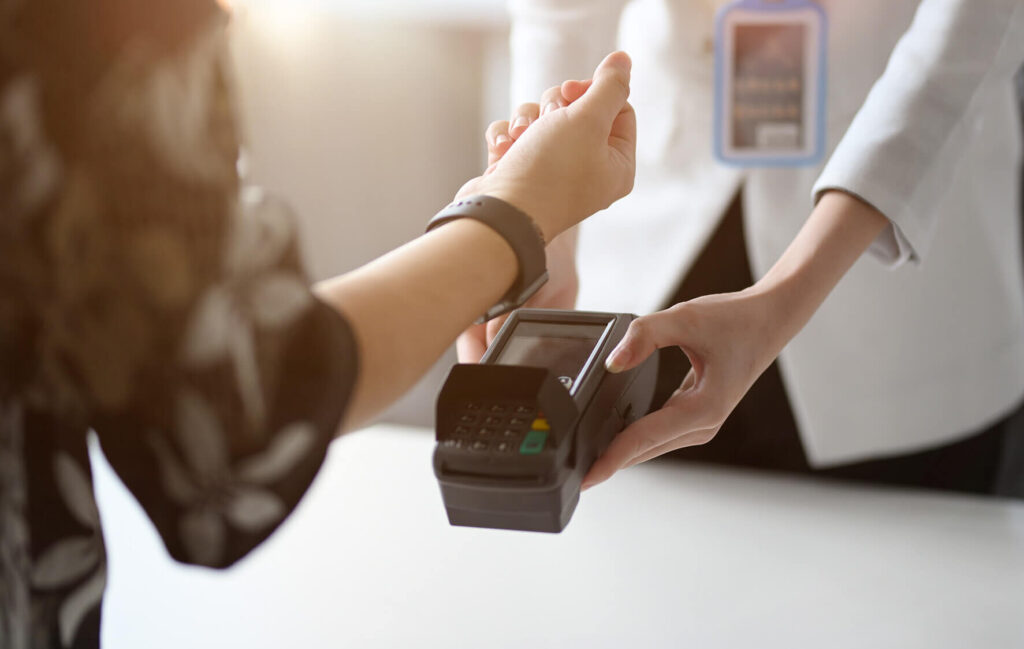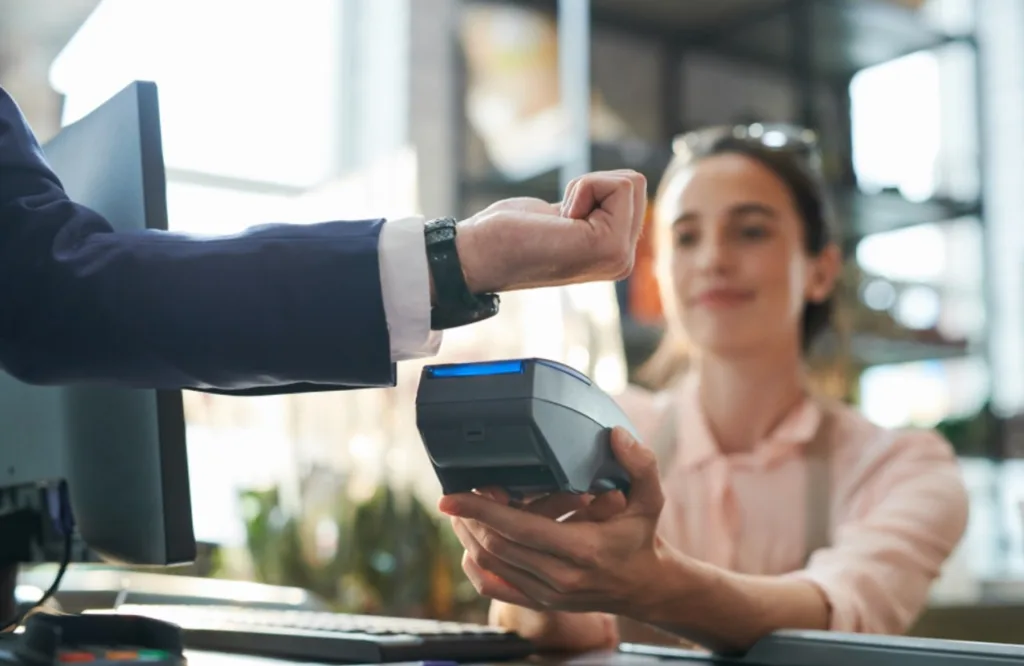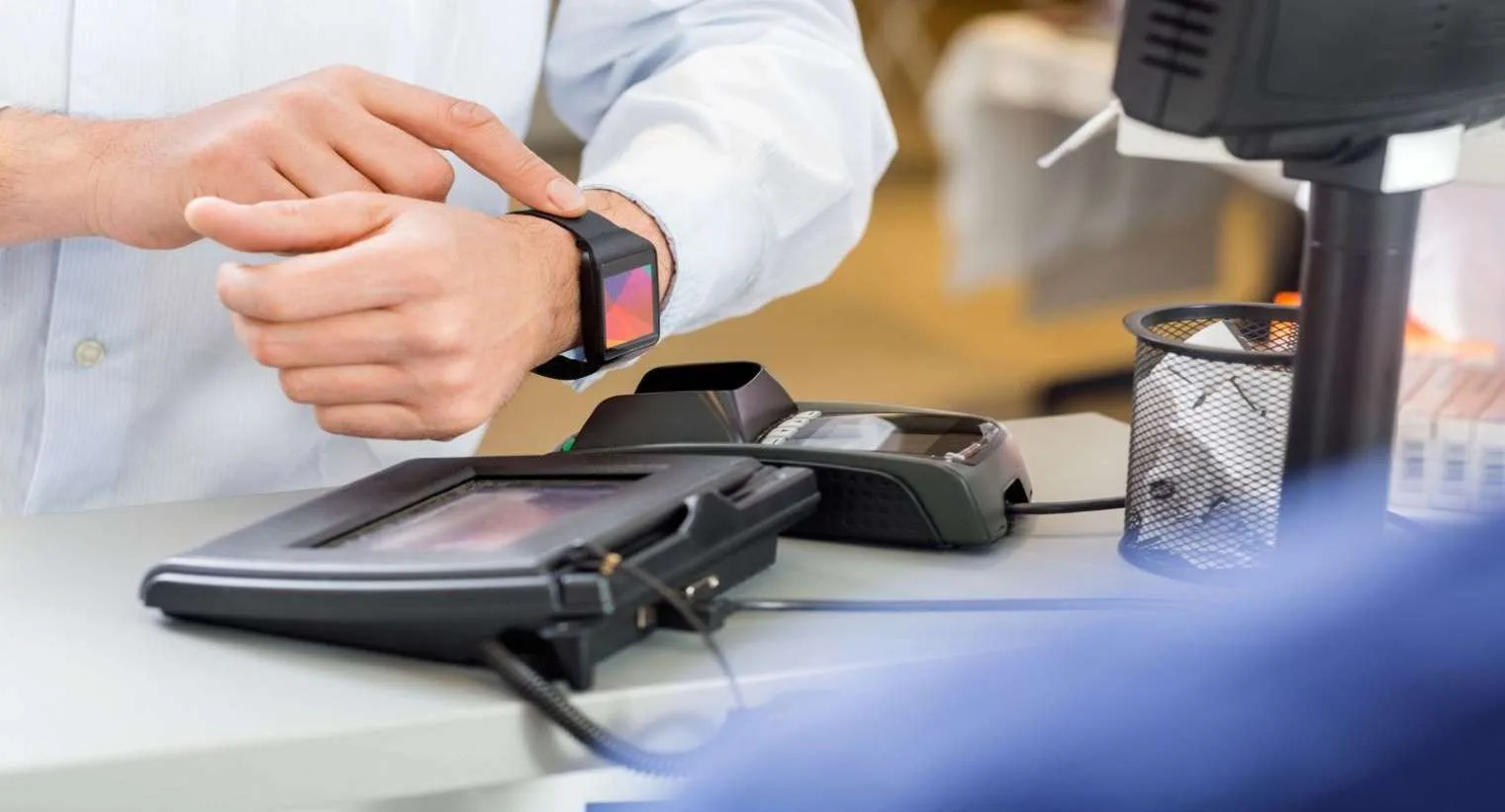The Future Of Wearable Technology In Banking
Wearable Technology in Banking is the way customers manage their financial processes using wearable technologies such as smartwatches and wristbands. With this new technology, customers can meet their daily banking needs without a mobile phone or computer.
In addition to many banking transactions such as balance inquiry, asset transfer, and contactless payment, it is expected that Wearable Technology in Banking examples will increase in the future.
For example, in today’s modern world, a good example would be someone making contactless payments with an Apple Watch.
Wearable technology, which is a customer-focused technology, will change your banking habits. The banking sector will continue to offer its services and products integrated with innovative technologies.
Who knows, maybe in the future, our smart watches with voice commands for all our financial transactions will be sufficient as a good example of wearable technology in banking.
What Is Wearable Technology In Banking And How Does It Work?

Wearable Technology in Banking is an innovative technology that enables faster management of operations for customers and banks. With wearable technology, daily tasks can be performed easier, faster, and in a more planned manner.
Wearable technology products have entered many areas of human life. Thanks to the rapid development of technology, societies have transitioned from an industrial society to an information society.
Nowadays, the important element is to have information and to be able to use this information most effectively.
The contribution of wearable technological products, whose production and sales have increased with the transition to an information society, to the economy is too much to ignore.
For businesses to gain a competitive advantage in the wearable technology market, they need to be the first company to enter the market or to be a company that produces innovative products by differentiating itself from its competitors.
There is very strong competition in a wide technology market and new features are added to the products produced every day or the existing product is completely renewed.
The competition of businesses to adapt to changing and developing technology greatly affects the integration of wearable technology products into the health, textile, education, entertainment and tourism sectors.
Benefits Of Using Wearable Technology In Banking Services
Wearable technologies, which are becoming increasingly popular every day, have become an indispensable part of our lives. It is a fact that life is safer, easier, healthier, faster, and more fun with wearable technologies. Wearable devices have potential benefits in many different areas.
They have many benefits that make life easier and increase efficiency and effectiveness for both users and companies in workplaces, customer service, manufacturing, industry, retail, healthcare, and fitness centers.
Wearable technologies are also candidates for significant breakthroughs in the health and sports industry. It is seen that consumers have adopted wearable technologies in the health and sports field and will use them more widely in the future.
Wearable devices will allow consumers to integrate with smartphones, tablets or PCs at home, on the move, while shopping in stores and while sleeping, and will change the education and productivity of employees.
On the other hand, wearable technologies will pave the way for employees to have ideas about how they spend their time closely, streamline processes, and maximize efficiency.
How Banks Are Adopting Wearable Technology For Customer Experience?
Many financial institutions, from traditional banks operating globally to those providing completely digital services, are increasingly offering integrated products and services with wearable technologies.
Daily financial transactions such as checking balances, transferring assets, making payments, and receiving payment notifications can already be done through smart watches. Banks are looking for ways to increase customer satisfaction faster and easier in the future.
Smart watches or smart bracelets that use biometric data prevent anyone other than you from entering the bank mobile application on your behalf. The gradual development of smart watches also improves the ability to perform financial transactions.
Today, many fintech companies continue to work in the field of wearable technology in banking. For this reason, this new sector could be an investment model with high profitability potential in the future.
Security Implications Of Wearable Technology In Banking
Thanks to NFC technologies that can be used with or without cards and wearables, and mobile banking applications that provide QR code integration, payment methods are one of the areas where digital transformation is most rapidly taking place.
One of the advantages of Wearable Technology in Banking is that it accelerates the verification process in security processes.
While contactless payments that aim to replace low-limit cash spending make it possible to make payments even in public transportation, the ability to withdraw money quickly and easily thanks to QR code-supporting ATMs and applications is changing user habits to a great extent.
Among the innovations in payment technologies, wearable payment technologies in particular attract great interest. Smart watches, payment rings, mobile payments and smart refrigerators with payment support are a few examples of new payment technologies that have been offered recently.
These new payment technologies, based on computer technology, the internet and telecommunications, are developing and becoming more widely used day by day.
New technologies developing in terms of payments include low-cost ways to store and transfer data. These technologies can reduce risk, but they can also cause new risks.
The Role Of Smartwatches In Wearable Technology In Banking

Smartwatches are devices that are compatible with the computer system and are worn on the wrist. They are preferred due to the convenience they provide in daily life. We can answer calls, look at our text messages, and check our e-mail accounts on smartwatches.
In addition to these, we can take photos and videos, listen to music and count our steps. Smart Clothing, Smart clothing that collects various information from body temperature to the effect of the weight lifted on the body can be useful in many areas.
For example, with the help of these clothes, we can learn the temperature, altitude and air pollution values of the environment we are in. Smartwatches such as Fitbit or Apple Watch are pioneering the way we track everything from our heart rate to our daily steps.
Constantly checking the health indicators mentioned (and perhaps becoming obsessed with them) has become a part of the daily routine for millions of people around the world.
Thanks to the Wearable Technology in Banking solutions that are added every day, new investment areas are also emerging for startups. These watches encourage healthier lifestyles by reminding people of this information through the data they collect.
Knowing how far you have gone in criteria such as step count, running, etc. encourages you to push harder to break your old record.
How Wearable Technology In Banking Enhances Real-Time Access?
Wearable technology products usually have an internet connection via a mobile phone, and thanks to this connection capability, they provide users with instant balance information, transaction notifications and other account balance alerts.
New generation customers, especially generation Z customers, can access financial information or transactions instantly with Wearable Technology in Banking.
Near field communication technology: NFC is a technology that has been used frequently in the financial sector since 2010, enabling contactless payments with mobile or wearable devices, with or without a card.
NFC technology, which has mostly been used in low-limit shopping, has also been increasing its usage limits over time. It largely eliminates the need to carry cash thanks to the fast and password-free shopping convenience it provides.
Research shows that NFC contactless payments are 7 seconds faster than payments made with cash.
Challenges In Implementing Wearable Technology In Banking
Wearable technological products that make our lives easier are becoming increasingly widespread.
This new technology allows us to answer calls, send text messages, and access our e-mails and social media accounts at any time. It also informs us of the number of steps we take throughout the day, how much energy we spend, and our sleep patterns.
Wearable technological products have become a part of our lives in recent years. These products cover all the technological devices we wear.
Smart watches, smart glasses, smart clothes, smart jewelry and smart bracelets are some of the wearable technological products.
Wearable technologies enable workers in every field in the workplace to establish the most efficient and harmonious relationship with the production process and each other and increase productivity, speed, and quality.
One of the most important lessons history has taught us is that it is meaningless to stand against the development of wearable technology in banking.
However, the inevitable result of this development is that workers are monitored more and more closely, opportunities to intervene in social and private life increase, and personal data is collected more than usual.
Monitoring the worker directly with a device he or she wears opens up a whole new dimension in these problematic areas.
Examples Of Banks Using Wearable Technology In Banking
Wearable Technology in Banking offers access to banking services in a personal and customized way. Today, many banks’ mobile applications can provide services integrated with wearable technology products.
Moreover, with the development of artificial intelligence tools and automation, in the near future, wearable technology products will be more solution-oriented in meeting our financial needs.
Examples of the use of popular wearable technology products such as smart watches in banking today can be listed as follows:
– Fast access to transaction history via smart watches,
– Receiving instant notifications about the expenses you make from someone else’s or your account,
– Preventing possible fraud cases by performing the verification process during the login process to mobile applications through biometric data.
– Providing access to your account 24/7, anywhere and under any conditions.
Future Outlook For Wearable Technology In Banking

Payment transactions made with wearable devices are the most widely used element of the Wearable Technology in Banking trend.
It is suggested that in the near future, smart textiles will constitute the most important part of the textile and ready-to-wear sector in terms of value. Functionality has become more prominent than ever in fashion history.
In today’s historical process, clothes are becoming increasingly comfortable and provide comfort and convenience to the user. Clothes now promise to support the human mind and communication skills as much as they provide physical convenience and performance.
Wearable payment technologies that have been widely used recently are accessories with contactless payment features such as smart watches, payment rings, and payment wristbands.
Mobile payment, which allows monetary transactions to be made via GSM companies via phone, and smart mirrors, which allow payment of products that are being tested with a smartphone, fingerprint readers that allow payment with biometric verification, and payment-supported smart refrigerators and smart ovens are used very frequently in the clothing sector.
Smart watches, which are the most widely used wearable technology today, help us live healthier lives by showing us data about our health such as how much we walk, how much we sleep, and how many calories we burn per day and by recording the information.
These smart watches are still being developed to make daily life easier and new features are being tried to provide solutions to make life easier. As a result of contactless payment solutions pioneered by MasterCard, payments can be made with smart watches.
Smart watches, which were developed to make payment transactions in a shorter time, can be integrated with an ATM or credit card via an application with NFC technology.
After the integration, the payment transaction can be completed by bringing the smart watches closer to the payment terminals or touching them at NFC-supported payment points.
How Fintech Is Driving Wearable Technology In Banking?
Thanks to Wearable Technology in Banking, mobile banking solutions are also developing. The technological developments that accelerated after the industrial revolution and the interdisciplinary collaboration of experts from various fields make it possible to create innovative products.
One of the best examples of multidisciplinary applications is smart-interactive textile products. One of the wearable contactless payment technologies developed to offer different options at the payment point is sweat and water resistant payment bracelets with different size options.
NFC-enabled bracelets allow people who do not want to carry wallets etc. with them, especially while doing sports, or those who travel by motorcycle to make payment transactions quickly and easily at contactless payment terminals with payment bracelets instead of payment tools that are in hard-to-reach places due to their clothes.
The basic uses of innovative products created as a result of the collaboration of experts and designers from branches such as informatics, electronics, and engineering are concentrated in the areas of health, security, entertainment, and communication.
In the twenty-first century, wearable technology in banking has an important place in the modern world markets.
See you in the next post,
Anil UZUN
